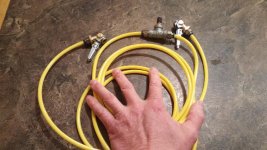mecsw500
Member
I use the following Amazon purchased product to set tire pressures:
AVID POWER Tire Inflator Portable Air Compressor, 12V DC / 120V AC Car Tire Pump, Air Mattress Pump with Inflation and Deflation Modes, Dual Powerful Motors, Digital Pressure Gauge
You dial in the tire pressure you want, press start and it inflates to the desired pressure and stops. Makes it easy to set both tires to the same pressure. I run 20 psi in the front Kendas.
I measured it against a calibrated gauge and it was less than 1/2 psi out. The connection hose has one of the better valve connections I've used and the whole unit seems pretty rugged, certainly for Spyder kind of pressures.
This one is 110 VAC powered as well which makes it easy to use in the garage, includes a battery backup for USB power storage in case the power goes out, you can't have too many of those battery backups.
So far so good, its lasted the season and seems to be still working fine. For the price it makes setting pressures on the Spyder really simple. A bit bulky to carry on the bike though.
It beats trying to get the fronts really balanced by hand with a pump and a gauge.
AVID POWER Tire Inflator Portable Air Compressor, 12V DC / 120V AC Car Tire Pump, Air Mattress Pump with Inflation and Deflation Modes, Dual Powerful Motors, Digital Pressure Gauge
You dial in the tire pressure you want, press start and it inflates to the desired pressure and stops. Makes it easy to set both tires to the same pressure. I run 20 psi in the front Kendas.
I measured it against a calibrated gauge and it was less than 1/2 psi out. The connection hose has one of the better valve connections I've used and the whole unit seems pretty rugged, certainly for Spyder kind of pressures.
This one is 110 VAC powered as well which makes it easy to use in the garage, includes a battery backup for USB power storage in case the power goes out, you can't have too many of those battery backups.
So far so good, its lasted the season and seems to be still working fine. For the price it makes setting pressures on the Spyder really simple. A bit bulky to carry on the bike though.
It beats trying to get the fronts really balanced by hand with a pump and a gauge.

